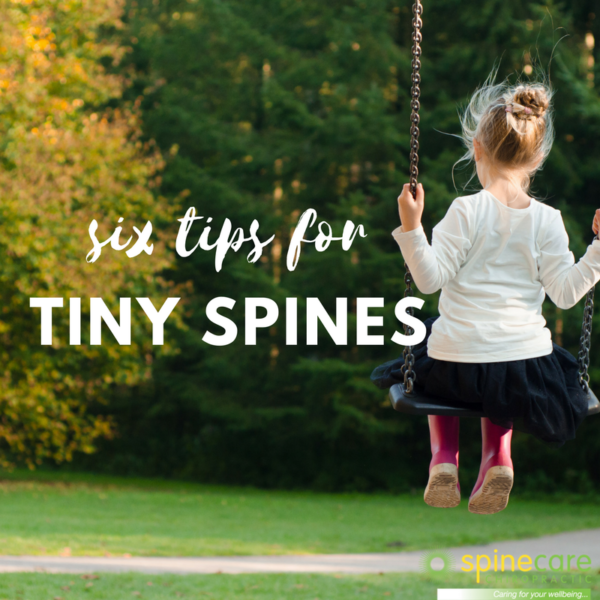Six tips for tiny spines

As you watch your kids hop down the steps and off to school, spare a thought for their spines!
Perhaps they’re obscured beneath oversized backpacks, bulging with books. Or maybe they’re flexing with first-day excitement. Whatever the state of your child’s spine, it’s a great idea to start taking care of it young.
In fact, between 7 and 17 years old, the spine’s length can increase by as much as 26%!
Not only is childhood a time of rapid growth, it’s a chance to cement good habits early – the kind that help avoid things like back pain, slipped discs and degeneration later in life.
With that in mind, we’ve compiled six simple – but essential – things to implement for small spines.
Back-friendly backpacks
Now, about that backpack…
While there’s no getting around a packed lunch or textbooks, you can pay attention to position and fit of your child’s backpack to make carrying them safer.
A surprising number of kids present to the emergency room for backpack-related injuries each year, and even more for neck, shoulder and back pain.
To minimise the risk of backpack-related spinal problems, look for wide, adjustable straps that spread the load evenly. Better still, a waist-strap for snug fitting above the hips, adding stability and support.
As a rough guide, your child should only carry 10% of their body weight. Heavier items are best stowed down the bottom and/or close to the spine.
If you need help fitting your child’s backpack, we’re here and happy to help.
Feed spine food
There’s no downside to making wholefoods a habit. And while we don’t often associate the spine with healthy eating, it must be fed just like the rest of the body.
Made of bone, cartilage, ligaments, muscle and nerves, the spine requires ample nutrition. Protein, calcium, magnesium, zinc, copper, vitamins A, D, C, E and K, B vitamins, essential fatty acids, minerals, antioxidants… in fact, there’s not much this living tissue doesn’t need.
Following the foundations of a balanced diet, including full-fat, organic (where possible) dairy, a range of protein sources (like slow cooked meats, fish, whole chicken – using the bones to make soup), seasonal fruits and veggies, whole grains and homemade treats will ensure your child builds a robust spine – and enjoys delicious meals, too.
Drink up
The spine craves hydration!
Between each vertebrae is a disc like a squishy shock-absorber, the center of which is made mostly of water. It’s effectively ‘squeezed’ each time you move and flex the spine and needs topping up with fluids regularly.
Kids need spine hydration, too – but sometimes enticing them to drink plain water is tough.
To make water more appealing, try adding things like frozen berries, a squeeze of orange juice, fresh mint leaves, goji berries… anything to make it that little bit tastier.
Drinks like coconut water, kefir, herbal teas, homemade ginger and ‘fizzy’ fruit drinks are yummy options, too.
Remember to pack a drink bottle each day for school!
Less iPad, more play
When they’re not at school, many kids gravitate towards iPads and phones for ‘play’. Not only is this problematic for social skills, fitness, coordination and imagination, it can also be damaging for the spine.
Just like adults, kids are at risk of ‘tech neck’, a uniquely modern affliction. It happens from looking down at devices, putting pressure and strain on the cervical spine.
Encourage kids to choose outdoor play or games of imagination instead. If they must use devices, make sure they’re sitting up at the table with good posture – never curled on the couch or slouching in bed.
Here’s a helpful article we wrote about how to maintain healthy posture.
Safe sport and stretching
Further to the above, sport and outdoor activities are great for kids. They help develop a sense of community, fair play and not least of all – fitness. However, it’s wise to be on the lookout for ‘little’ injuries that could cause trouble down the track.
Address bumps and falls immediately, and make sure they’ve been treated or cleared by a qualified professional.
Get kids in the habit of warming up, cooling down and stretching before and after games, minimizing the risk of injury.
And of course, ask next time you’re at the practice for a safe and easy stretching routine for your kids.
Posture police
You won’t be called cool, but they will thank you later.
Gentle reminders about good posture are vital to protecting your child’s spine for life. Far from trivial, poor posture can affect everything from mood to number twos. We talk more about the effects of bad posture here – well worth a read.
Put simply, encourage kids to keep their shoulders back and down, belly button pulled gently in and chin slightly tucked. While sitting, ensure their feet are flat, legs uncrossed and forearms parallel to the table. This article goes into detail.

